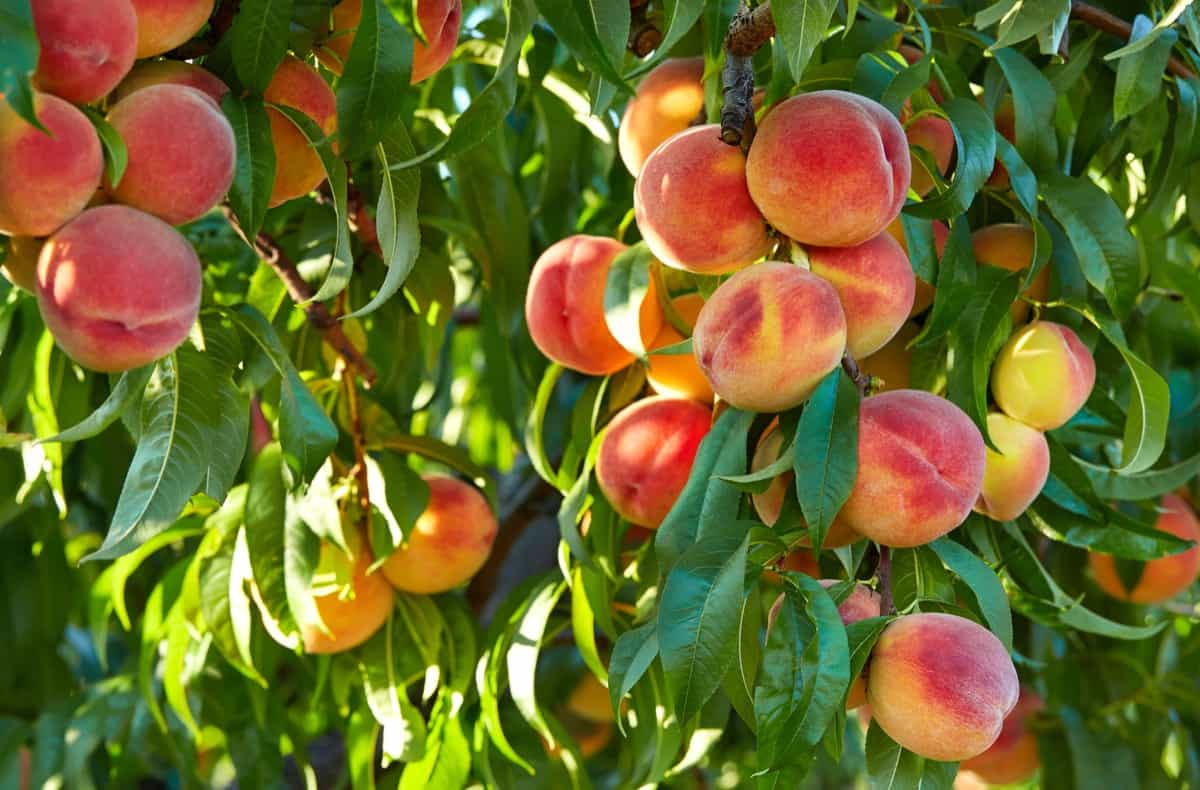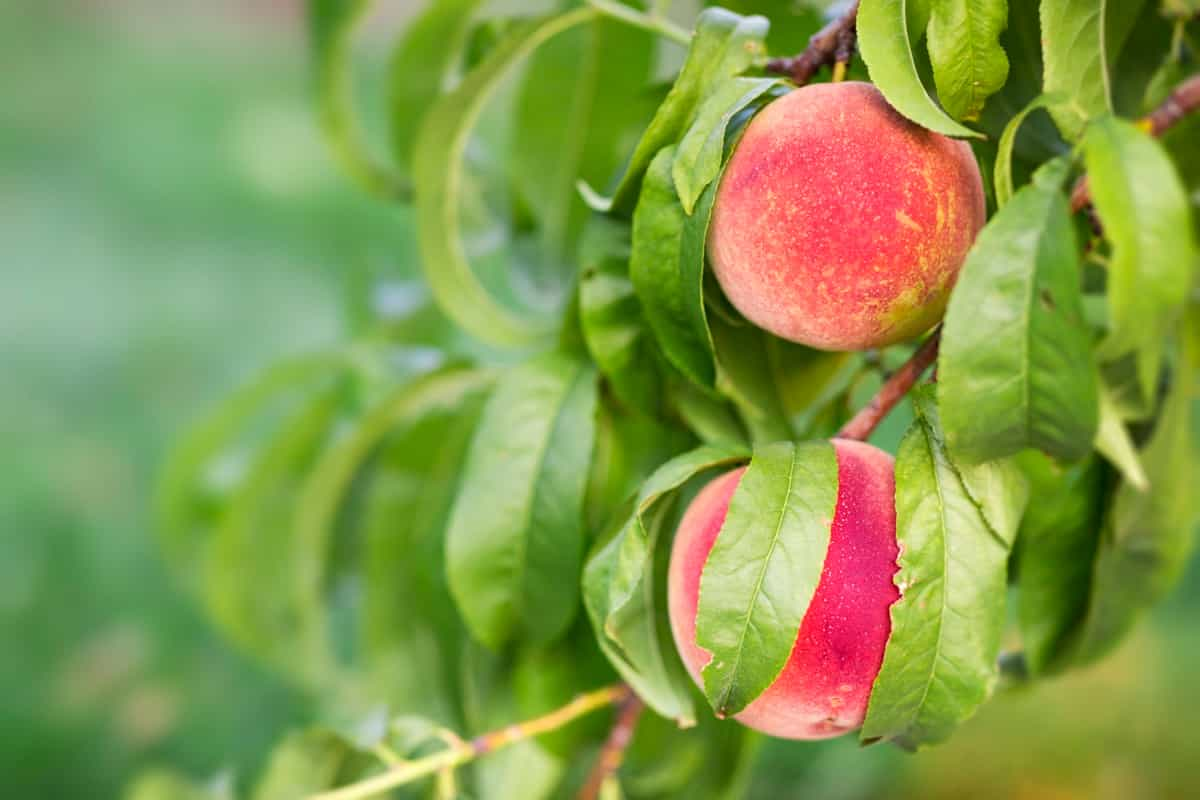The peach leaf curl, also called curly leaf or curly blight, is a common disease recognized since the early 1800s. The Taphrina deformans fungus causes this disease and affects peaches and nectarines’ blossoms, fruit, leaves, and shoots. One of the most common diseases found in backyard orchards is peach leaf curl. During the first few days after leaves open, cool (9-20°C) wet weather favors the disease.

Natural and Organic Ways to Treat Peach Leaf Curl
Organic Fungicides for Peach Leaf Curl
Biological fungicides are derived from naturally occurring microorganisms or their by-products and offer an organic and sustainable approach to controlling peach leaf curl. These fungicides contain beneficial microorganisms, such as Bacillus subtilis or Trichoderma spp., which actively compete with the pathogenic fungi, preventing their growth and colonization on the tree. Biological fungicides are safe for beneficial insects and pollinators while effectively managing the disease.
Neem Oil Treatment for Peach Leaf Curl
- Timing: Apply neem oil during the dormant season, preferably in late winter or early spring before bud break. This will help protect the emerging foliage from fungal infection.
- Dilution: Mix neem oil with water according to the manufacturer’s instructions. Generally, a concentration of 2-4% neem oil is recommended for effective control.
- Spraying: Thoroughly coat the entire tree, paying close attention to the branches, buds, and emerging leaves. Ensure complete coverage of all affected areas, including the upper and lower leaf surfaces.
- Repeat Applications: For optimal results, repeat the neem oil treatment every 7-14 days until the bud break is complete. This will provide continued protection and prevent new infections.
Copper-based Sprays for Peach Leaf Curl
One popular organic copper-based spray for peach leaf curl is the Bordeaux mixture. Bordeaux mixture is a copper sulfate and hydrated lime combination. It has been used for many years to control various fungal diseases, including peach leaf curl. When applied during the dormant season, the Bordeaux mixture forms a protective barrier on the peach tree’s buds and prevents the fungus from infecting the leaves.
Copper hydroxide is a fungicide that disrupts fungal cells and prevents their growth. It is available in various formulations, such as liquid concentrate or wettable powder. Copper hydroxide should be applied to the peach tree’s foliage during the dormant season or when the buds swell. It is important to note that copper hydroxide should not be combined with oil-based sprays, which can cause phytotoxicity.
Sulfur Treatment for Peach Leaf Curl
Organic sulfur, also known as elemental sulfur, is a natural mineral that has long been used in agriculture to control various fungal diseases. It acts as a fungicide by preventing the growth and spread of fungal spores. When applied to peach trees, organic sulfur forms a protective barrier on the leaves, preventing the fungal infection from taking hold.
Applying Organic Sulfur Treatment
- Timing: Apply the treatment during the dormant season, before the bud swell, ideally in late winter or early spring.
- Preparation: Mix the organic sulfur product according to the manufacturer’s instructions. Wear protective clothing, gloves, and a mask to avoid direct contact with the sulfur.
- Application: Thoroughly spray the organic sulfur solution on the entire tree, covering all buds and branches. Pay special attention to the leaf buds most susceptible to infection.
- Reapplication: Repeat the treatment after 10-14 days, especially if there are signs of new leaf growth, or the weather conditions favor disease development.
Pruning Infected Branches to Treat Peach Leaf Curl
Pruning, including removing diseased leaves and shoots, can be employed as a preventative measure to help combat peach leaf curl. Regular pruning will increase the tree’s air circulation, allowing it to dry faster after rain. Pruning encourages the growth of new shoots and leaves, and more healthy and strong shoots will mean more leaves.
In case you missed it: Project Report of 1-Acre Peach Farming: Cost and Profit Analysis

Promoting Beneficial Insects
Beneficial insects play a vital role in maintaining the balance of ecosystems and can help control pests naturally. Here are some beneficial insects that can be encouraged to combat peach leaf curl:
Ladybugs: They, also known as lady beetles, are voracious predators of aphids, which are common pests that can transmit peach leaf curl. By attracting ladybugs to your peach trees, you can reduce aphid populations and indirectly help control the spread of the disease.
Lacewings: Lacewings are delicate insects with translucent wings. They are known for their voracious appetite for soft-bodied insects, including aphids. You can increase their population and enhance natural pest control by providing a habitat for lacewings, such as planting flowering plants that attract them.
Parasitic Wasps: Certain parasitic wasps are natural enemies of aphids and other pests. These tiny wasps lay their eggs inside aphids, eventually killing the insects. By providing suitable habitats, such as flowering plants and sheltered areas, you can encourage the presence of parasitic wasps and enhance the biological control of peach leaf curl.
Using Resistant Peach Varieties
Redhaven Peach: Known for its excellent flavor and resistance to peach leaf curl, the Redhaven Peach is a popular choice among peach enthusiasts. This variety produces medium-sized, firm peaches with vibrant red skin.
Avalon Pride Peach: The Avalon Pride Peach is a relatively new variety that offers excellent resistance to peach leaf curl. It produces medium-sized, juicy peaches with yellow skin and attractive red blush. This variety is also known for its cold hardiness, which suits regions with cooler climates.
Red Wing Peach: One of the standout features of the Red Wing peach tree is its exceptional resistance to peach leaf curl. Red Wing exhibits strong natural resistance to this fungal disease, making it less susceptible to infection than other varieties.
Maintaining Proper Tree Spacing
When planting peach-leaf curl trees, it is crucial to consider the mature size of the trees. Peach leaf curl trees typically reach a height of 15 to 25 feet and have a spread of 15 to 20 feet. To allow for adequate sunlight penetration and air circulation, each tree should be spaced at least 15 to 20 feet apart.
In addition to the distance between trees, it is also important to consider the spacing between rows. The ideal spacing between rows depends on the equipment you use for maintenance and harvesting. A minimum spacing of 12 to 15 feet between rows allows easy access and maneuverability.
Applying Compost or Organic Mulch Around the Base of the Tree
When applying compost or organic mulch around the tree’s base, there are a few key considerations to remember. Firstly, ensure that the mulch or compost is applied in a layer approximately 2-3 inches thick. This thickness allows for effective moisture retention and weed suppression without suffocating the tree’s roots.
Keep the mulch or compost a few inches away from the tree trunk. Direct contact between the tree and the organic matter can create a moist environment that may promote rot or other diseases. By maintaining a gap, you can prevent potential damage to the tree and promote proper air circulation around the trunk. In terms of timing, it is best to apply compost or mulch in the late winter or early spring.
In case you missed it: 10 Common Problems With Peace Lily Plants: Treatment and Solutions

Conclusion
Several natural and organic ways to treat peach leaf curl exist. By incorporating these home remedies into your peach tree care routine, you can protect your trees and enjoy a healthy harvest.
- Ultimate Guide to Ossabaw Island Hog: Breeding, Raising, Diet, and Care
- Ultimate Guide to Juliana Pig: Raising Facts, Size, Diet, Care, and Lifespan
- Raising Lleyn Sheep: Disadvantages, Price, Uses, Characteristics, and Care
- Ultimate Guide to Meishan Pig: Breed Facts, Breeding, Raising, and Care
- Ultimate Guide to Teacup Pigs: Raising, Diet, Lifespan, Cost, and Care
- Guide to Raising Poll Dorset Sheep: Facts, Profile, Characteristics, Uses, and Care
- Ultimate Guide to Bighorn Sheep: Characteristics, Diet, Lifespan, Breeding, and Lifecycle
- Ultimate Guide to Raising Katahdin Sheep: Farming Facts, Breed Profile, Uses, and Care
- Ultimate Guide to Raising Oreo Cows: Belted Galloways Farming Facts, Profile, Uses, and Care